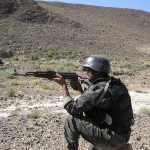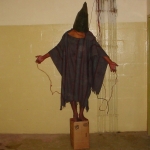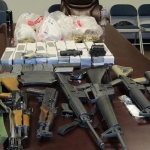DynCorp-State Department Contract
Corpwatch has acquired a copy of a $600 million dollar contract between DynCorp and the U.S. State Department. The company carries crop fumigation and eradication against coca farmers in Colombia, Bolivia and Peru. In Colombia it is also involved in drug interdiction, transport, reconnaissance, search and rescue missions, medical evacuation and aircraft maintenance, among other operations.--Editor
 | DynCorp-State Department Contract |
SECTION C - DESCRIPTION/SPECIFICATIONS/STATEMENT OF WORK
(FOR DEFINITIONS OF TERMS SEE EXHIBIT 1 PAGE 75)
C.0. INCORPORATION OF CONTRACTOR'S TECHNICAL PROPOSAL (05/95)
(a) The Contractor shall perform this contract in accordance with its technical proposal dated
September 24, 1996 and any revisions thereto submitted in response to Solicitation
No. S-OPRAQ-96-R-0545.
(b) The Contractor's technical proposal is incorporated by reference and hereby made subject to
the provisions of the "ORDER OF PRECEDENCE" clause in SECTION I of this contract. Under
the "ORDER OF PRECEDENCE" clause, the Contractor's technical proposal shall follow "the
specifications" in the order of precedence.
C.1. GENERAL PROGRAM DESCRIPTION.
A. SECTION C.1: Section C.1 presents an overview of the Bureau for International
Narcotics and Law Enforcement Affairs (INL), Office of Resource Management, Aviation
Division (AD) and its associated missions, tasks, and aircraft. Operations outside the United
States are conducted in accordance with bilateral agreements with individual host countries and,
as such, vary from country to country. Mission deployments may be to any worldwide location,
including, potentially, outside of Central and South America.
B. SECTION C.2: Section C.2 entitled, "General Tasks" identifies the general
requirements of the AD Counternarcotics Aviation Program to include operations and
maintenance, logistics management and support and the necessary management services required
for each of the following Contract Line Item Numbers (CLINS):
CLIN NO. DESCRIPTION
CLIN 0001 Main Operating Base (MOB) located at Patrick Air Force Base (PAFB),
FL
CLIN 0002 Data (See DD Form 1423, Section C, Exhibit IV)
CLIN 0003 Bolivia
CLIN 0004 Colombia
CLIN 0005 Reserved
CLIN 0006 Peru
CLIN 0007 Deployment Program
CLIN 0008 CPAF Task Orders
CLIN 0009 FFP Task Orders
CLIN 0010 Defense Base Act Insurance
C. SECTION C.3: Section C.3 provides specific information on each country or
location mission and further elaborates on the tasks identified under paragraph ( B) above which
include: operations and maintenance services, logistics management and support, and
management services.
D. SECTION C.4: Section C.4 provides general information on personnel
qualifications and responsibilities of the AD program. Specific language requirements, position
descriptions and minimum qualifications are provided under Section J, Attachments Number 8,
"Key Personnel Requirements" and Number 9, "Labor Classification Descriptions (Non Key
Personnel)".
C.1.1. AVIATION DIVISION (AD) MISSIONS
C.1.1.1. PRIMARY MISSIONS The three primary narcotics missions of the AD
Counternarcotics Aviation program are eradication, training, and interdiction defined as follows:
A. ERADICATION The AD currently uses fixed wing agricultural spray aircraft and
occasionally rotary wing aircraft for aerial eradication of marijuana, coca and opium poppy. The
AD also uses utility helicopters to transport host country personnel to growing sites for manual
eradication of narcotics crops.
B. TRAINING Formal pilot training on the T-65 and OV-10 spray aircraft is conducted
by the Contractor in the conterminous United States (CONUS) as required with advanced
training conducted in certain host countries. An L-19 aircraft (Government furnished) will be
used in the training program if required. The Contractor shall provide on-the-job training of host
country pilots and Night Vision Goggle (NVG) observers in NVG operations. The Contractor
shall, to the extent approved by the Contracting Officer's Representative (COR), participate in
providing formal training to implement Narcotics Affairs Section (NAS) plans to develop host
government institutional maintenance capabilities; and informal on-the-job training of host
country pilots and mechanics to fly and maintain fixed and rotary wing aircraft. Additionally,
the Contractor shall provide on-the-job training of host country pilots, NVG observers, and
mechanics in the operation of Aviation Life Support Equipment (ALSE) and NVG equipment
including inspection, maintenance, standardization and quality control.
C. INTERDICTION Utility helicopters are also used to transport host country
personnel for interdiction of narcotics processing laboratories and narcotics being transported
within the host country. These missions may be conducted day, night or under cover of darkness
using NVG equipment and procedures.
C.1.1.2. SECONDARY MISSIONS All other missions are secondary and shall be performed
in support of eradication and interdiction. These secondary missions include:
A. TRANSPORT This mission involves the movement of personnel and/or supplies
between and within host countries. Currently Casa 212 and C-208 aircraft are being used for this
purpose in Temporary Duty (TDY) deployments.
B. RECONNAISSANCE This mission involves the use of aircraft to detect fields of
illegal narcotics crops, clandestine airfields, and narcotics processing laboratories. Generally,
only spray aircraft and helicopters are used in reconnaissance missions.
C. SEARCH AND RESCUE This mission involves the use of helicopters to locate and
rescue Contractor and host country air crews and U.S. and host country law enforcement
personnel, including military. This operation deals with downed aircraft or hostile action by
narcotics producers or traffickers.
D. MEDICAL EVACUATION (MEDEVAC) This mission involves the use of
aircraft and equipment to evacuate personnel injured by accidents or hostile action.
E. FERRY This mission involves the movement of aircraft from one host country to
another and within countries. The Contractor is responsible for most ferry operations.
Helicopters are normally moved to a designated location for shipment on an AD scheduled Air
Force C-5, C-17, C-130, or C-141.
F. MAINTENANCE This mission includes functional check flights following
maintenance actions.
C.1.2. AIRCRAFT Aircraft covered under this contract include the type and number of aircraft
in the deployment schedule (Table 1-1). Types of aircraft include utility helicopters, fixed wing
spray aircraft, training aircraft, and cargo/personnel transport aircraft. These aircraft and any
subsequent aircraft will be Government Furnished Property to the aviation services Contractor.
Aircraft may be titled to the U.S. Government or host country. Short term aircraft support
requirements may be added by Task Order (see CLINS 0008 and 0009 and Section C, Exhibit V
- General Task Order Description).
For more of this contract, please download the PDF Version, DynCorp-State Department Contract (File Size: 918KB).
- 18 CSC/ DynCorp
- 23 Private Security
- 124 War & Disaster Profiteering



